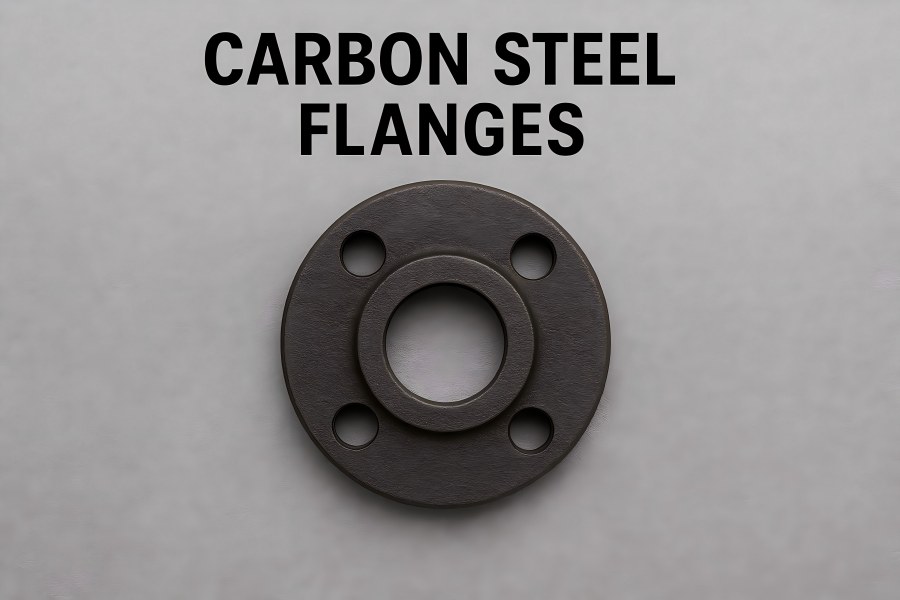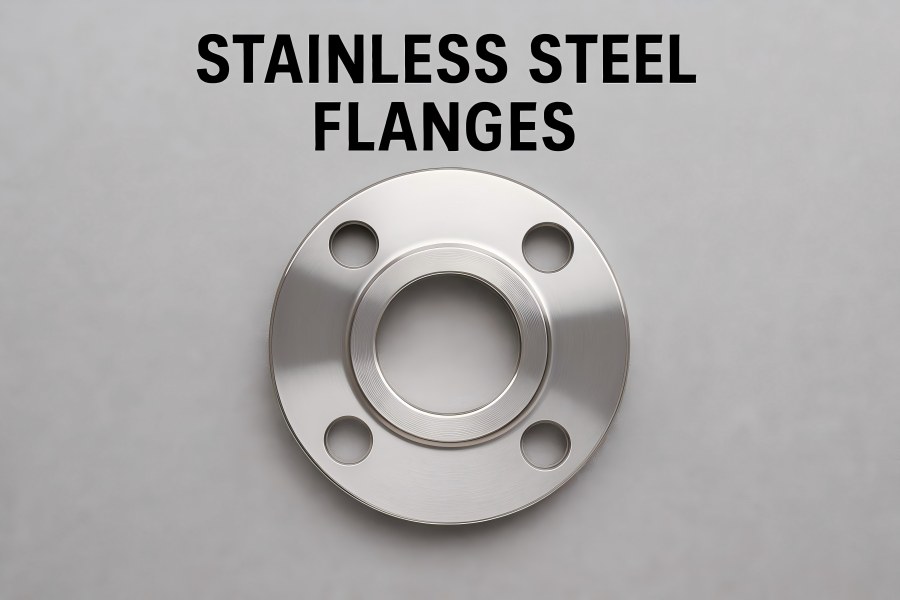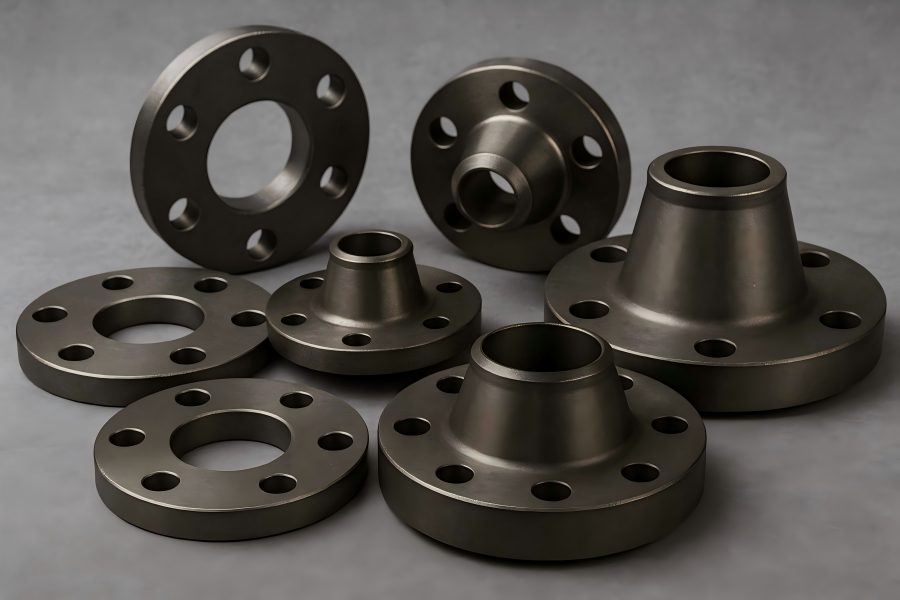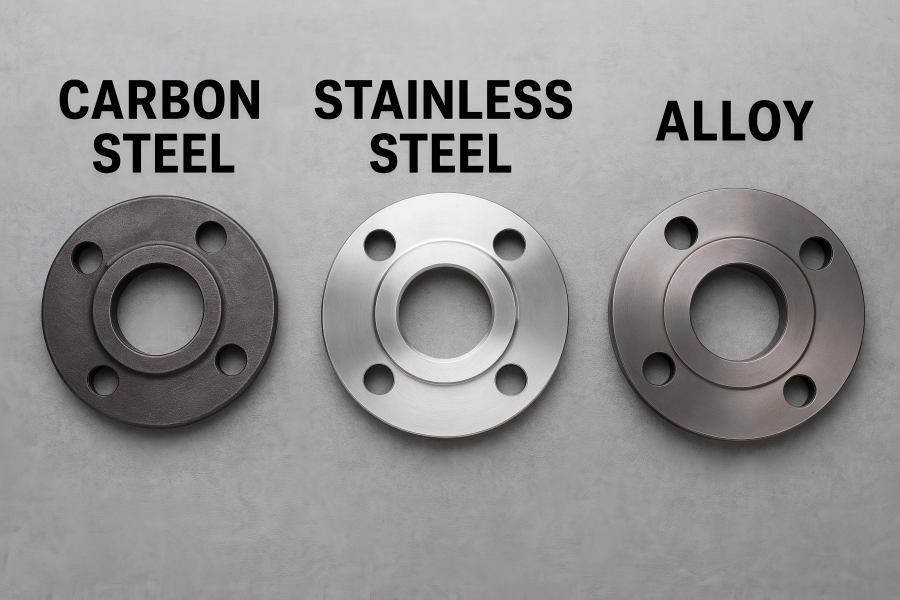When it comes to piping systems and industrial connections, flanges play a critical role in ensuring leak-proof performance, mechanical stability, and ease of maintenance. But even more important than the flange design is the choice of material.
Selecting between carbon steel, stainless steel, and alloy flanges can significantly affect a system’s performance, longevity, and overall cost. Each material has its own characteristics—ranging from corrosion resistance and tensile strength to thermal stability and machinability—that make it more or less suitable for specific operating environments.
This guide offers a comprehensive comparison to help buyers, engineers, and procurement managers make informed decisions.
Understanding Flange Materials and Their Role
Flanges act as the connecting interfaces in pipelines, valves, and pumps, enabling assembly, disassembly, and maintenance without welding the entire line. The material of the flange must match the mechanical and chemical conditions of the service environment—pressure, temperature, medium composition, and potential corrosion.
Selecting the incorrect flange material might result in disastrous failures such fatigue cracking, corrosion, or leaking. On the other hand, the right material ensures that the system remains reliable under stress, maintains dimensional stability, and resists degradation over time.
The three most common flange materials—carbon steel, stainless steel, and alloy steel—represent distinct categories of performance and cost.
Carbon Steel Flanges

Composition and Properties
Carbon steel flanges are chiefly composed of iron and carbon, containing small quantities of silicon, manganese, and other trace elements. The carbon content, which is usually between 0.05 and 0.30 percent, determines the steel’s hardness and strength. Common carbon steel grades for flanges include ASTM A105, A350 LF2, A694 F42–F65, and A216 WCB.
Key properties:
- Moderate tensile strength (around 415–550 MPa)
- Good machinability and weldability
- Limited corrosion resistance without protective coatings
- Economical and widely available
| Pros | Cons |
| Low cost and highly economical | Prone to corrosion without coating |
| Suitable for general-purpose use | Loses toughness at low temperatures |
| Easy to machine and weld | Scales at high temperatures |
| Ideal for large installations | Requires regular maintenance |
| Widely available and versatile | Limited chemical resistance |
Common Applications
- Oil and gas transportation (non-sour service)
- Steam lines and process piping
- Power plants and mechanical systems
- HVAC and fire-protection networks
In essence, carbon steel flanges strike a balance between affordability and mechanical reliability, provided that environmental protection is in place.
Stainless Steel Flanges

Composition and Properties
To increase their strength and resistance to corrosion, stainless steel flanges are alloyed with nickel, chromium (≥10.5%), and other elements like molybdenum or nitrogen. The protective chromium oxide film formed on the surface prevents rust and oxidation.
Common stainless grades for flanges include 304/304L, 316/316L, 321, and 347.
Key properties:
- Excellent corrosion and oxidation resistance
- High tensile and yield strength (500–700 MPa)
- Resistance to scaling and chemical attack
- Hygienic and aesthetically appealing surface
| Pros | Cons |
| Excellent corrosion resistance | Higher initial material cost |
| Performs well under high temperature and pressure | May gall during bolting |
| Requires minimal maintenance | Greater thermal expansion stress |
| Hygienic and easy to clean surface | Needs lubrication or surface treatment |
| Long service life and durability | Heavier than carbon steel alternatives |
Common Grades and Uses
| Grade | Key Features | Typical Applications |
| 304 / 304L | General-purpose, good weldability | Food, beverage, water systems |
| 316 / 316L | Mo-enhanced corrosion resistance | Marine, chemical, and offshore environments |
| 321 | Stabilized with titanium | High-temperature pipelines |
| 347 | Niobium-stabilized, good creep strength | Power generation and heat exchangers |
Application Examples
- Chemical and petrochemical plants
- Marine and offshore structures
- Food processing and clean water systems
- Pharmaceutical production lines
- Heat exchangers and cryogenic systems
Summary: Stainless steel flanges justify their cost in environments where corrosion resistance and longevity outweigh initial investment.
Alloy Steel Flanges

Composition and Classification
Alloy steel flanges incorporate various alloying elements—such as chromium, molybdenum, nickel, vanadium, and boron—to enhance strength, toughness, and resistance to temperature extremes.
Depending on the alloy content, they are divided into:
- Low-alloy steels: <5% alloying elements (e.g., A182 F11, F22)
- High-alloy steels: >5% alloying elements (e.g., Inconel, Monel)
Key Properties
| Pros | Cons |
| Excellent strength at high temperature and pressure | Higher cost than carbon steel |
| Adjustable alloy composition for performance | Requires precise heat treatment |
| Long service life in harsh environments | May lose ductility if over-hardened |
| Strong resistance to oxidation and creep | Needs specialized welding procedures |
| Reliable for critical industrial applications | Requires detailed inspection and testing |
Typical Grades and Applications
| Alloy Grade | Characteristics | Applications |
| ASTM A182 F11 / F22 | Cr-Mo alloy for high-temperature service | Refineries, power plants |
| ASTM A182 F5 / F9 | Enhanced oxidation resistance | Steam lines, superheaters |
| Inconel / Monel | Nickel-based, corrosion-resistant | Offshore and chemical processing |
| Chrome-Moly Steel | Strength and hardness retention at high temp | Pressure vessels and boilers |
Summary: Alloy steel flanges are the go-to choice for environments that exceed the thermal and mechanical limits of carbon and stainless steel.
Comparative Analysis: Carbon vs. Stainless vs. Alloy Flanges
| Property | Carbon Steel | Stainless Steel | Alloy Steel |
| Cost | Low | High | Moderate to High |
| Corrosion Resistance | Low | Very High | High |
| Strength at High Temperature | Moderate | High | Very High |
| Cryogenic (Low-Temperature) Performance | Poor | Excellent | Very Good |
| Maintenance Needs | High | Low | Moderate |
| Weldability | Excellent | Good | Good (requires control) |
| Typical Applications | Water, oil, and steam systems | Chemical, marine, and food industries | Power, refinery, and aerospace applications |
Key Takeaways:
- Choose carbon steel for cost-sensitive projects with mild operating conditions.
- Choose stainless steel when corrosion resistance and cleanliness are paramount.
- Choose alloy steel for environments that are high-pressure, high-temperature, or chemically aggressive.
Factors to Consider When Selecting Flange Material
Operating Environment
- Temperature: High temperatures (>400°C) require alloy steels with good creep strength.
- Corrosion Exposure: For seawater or acidic environments, stainless or nickel-based alloys are recommended.
- Pressure Rating: Materials must comply with ASME pressure–temperature ratings for the desired class (e.g., Class 150, 300, 600).
Compatibility with Piping Materials
Flanges and pipes should have similar thermal expansion rates and electrochemical potentials to avoid stress or galvanic corrosion.
Standards and Certifications
Common standards include:
- ASME B16.5 / B16.47: Flange dimensions and ratings
- ASTM A105 / A182 / A350: Material specifications
- API 6A / MSS-SP-44: Oil and gas service requirements
When sourcing flanges, always verify material test reports (MTRs) and certifications like ISO 9001, PED, and API Q1.
Cost–Performance Balance
While stainless and alloy flanges have higher upfront costs, they can deliver lower lifetime costs through reduced maintenance and longer service life.
Maintenance and Inspection
Carbon steel requires frequent repainting and inspection for corrosion, whereas stainless steel systems may only need periodic cleaning. Alloy flanges should be regularly tested for fatigue or creep in high-pressure systems.
Supply Chain and Lead Time
Availability of specific grades can affect project schedules. Carbon steel is typically stocked widely, while certain nickel or molybdenum alloys may have long procurement cycles.
Industry-Specific Recommendations
Oil and Gas Industry
- Carbon steel (A105, A350): Common for crude and gas transport lines.
- Alloy steel (F11, F22): Preferred in refineries for high-temperature reactors.
- Stainless (316L): Used in sour service and offshore conditions.
Chemical and Petrochemical Industry
Corrosive acids, solvents, and oxidizers demand 316L or higher-grade stainless steel, while Inconel or Hastelloy flanges handle the most aggressive chemicals.
Power Generation
Boilers, turbines, and heat exchangers operate at high temperature and pressure. Chrome-moly alloy flanges (F5, F9, F22) provide the required creep strength and oxidation resistance.
Water and Wastewater
Carbon steel with coatings is cost-effective for treated water, but stainless 304/316 offers superior durability in desalination and wastewater applications.
Food and Pharmaceutical
Only stainless steel (304L, 316L) ensures hygienic surfaces and resistance to cleaning agents. Mirror-polished finishes prevent microbial growth.
Marine and Offshore
High chloride exposure and salinity require 316L, duplex (2205), or super duplex (2507) stainless flanges with exceptional pitting and crevice corrosion resistance.
Lifecycle Cost Consideration
A realistic material decision should include Total Cost of Ownership (TCO):
- Initial purchase price
- Installation and maintenance costs
- Downtime or replacement risk
Although carbon steel may save up to 40–60% initially, corrosion and coating maintenance can double its cost over a decade. Stainless and alloy flanges, despite higher prices, may offer 15–20 years of uninterrupted service.
A simplified cost comparison (10-year projection):
| Material | Initial Cost (USD) | Maintenance (10 years) | Replacement Risk | Total Cost (10 years) |
| Carbon Steel | 100 | 150 | 50 | 300 |
| Stainless Steel | 160 | 40 | 20 | 220 |
| Alloy Steel | 200 | 60 | 10 | 270 |
Practical Tips for Buyers
- Check operating data before ordering—temperature, pressure, medium composition.
- Match flange material with pipe material to prevent galvanic corrosion.
- Request MTRs and NDT certifications from suppliers.
- Consider long-term project goals: short-term savings vs. lifetime reliability.
- Consult with engineers or suppliers about available surface treatments or coatings.
- Ensure compliance with international standards (ASME, ASTM, EN, JIS).
Conclusion
Choosing the right flange material is more than a matter of price—it’s a strategic decision that determines the safety, efficiency, and durability of your entire piping system.
- Carbon steel is ideal for cost-sensitive applications with minimal corrosion risk.
- Stainless steel provides superior resistance and hygiene where purity or corrosive exposure matters.
- Alloy steel excels under extreme temperatures, pressures, or chemically aggressive conditions.
